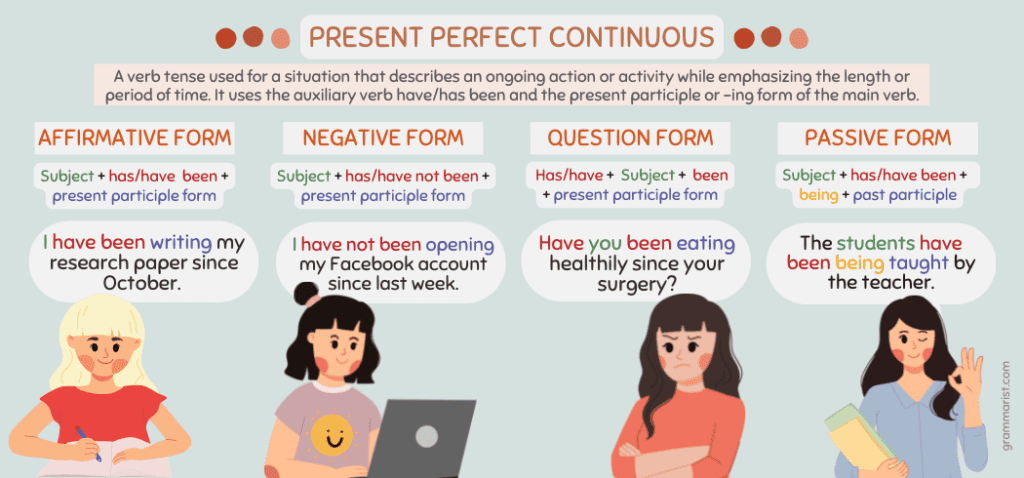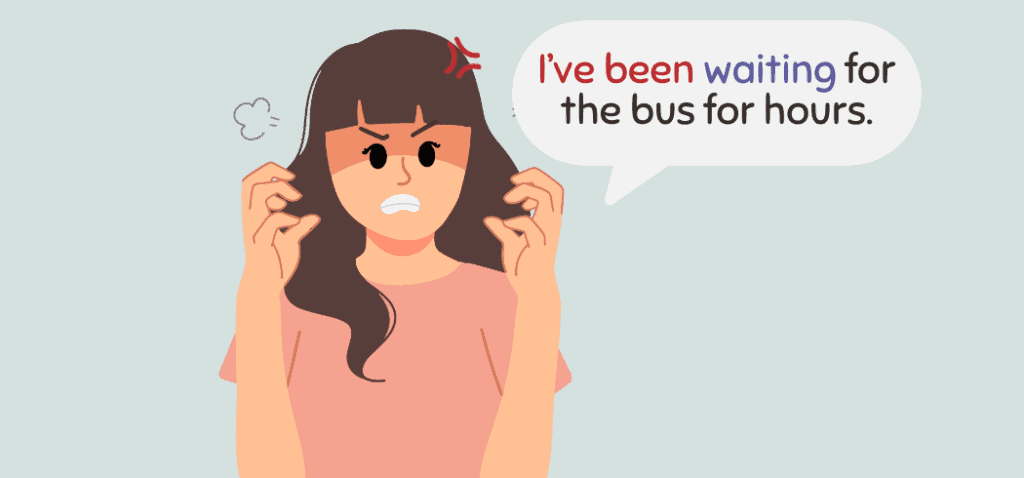What makes the statement, “I’ve been watching that TV series” different from “I’ve watched that TV series”?
The first statement is in the present perfect continuous tense, expressing an ongoing process for a specific time duration.
The uses and formulas of the present perfect continuous tense are easy to learn, as I’ll show you below.
Present Perfect Continuous Tense

A verb is a part of speech in English grammar expressing time while showing an action, condition, or existence of something.
The present perfect continuous or progressive tense is a verb tense used for a situation that describes an ongoing action or activity while emphasizing the length or period of time.
A present perfect continuous verb uses the auxiliary verb have/has been and the present participle or -ing form of the main verb.
Here’s a little excerpt from a book I wrote to show you what I mean:
She’s been watching me every day; I can feel her eyes on me everywhere I go. I’m trapped in this house until someone stops this craziness.
It’s not like the present perfect simple tense that describes the completion of a process in the recent past or the simple present tense that describes a habitual action.
It also differs from the present progressive tense, which describes a temporary, ongoing action.
Consider this pair of examples:
- Present perfect: I’ve read that book. (shows an idea of finished action or the idea of completion)
- Present perfect continuous: I’ve been reading that book. (Ongoing activity)
Present Perfect Continuous Forms
The present continuous perfect form uses a grammatical combination of has/have + been + present participle form of the verb. The present participle form of the verb is the simple form with an -ing ending.
Here is the formula for positive sentences:
- Subject + has/have been + present participle form + rest of sentence.
For example:
- John and Julia have been raising a child since November.
Negative sentences use the word not. Here is the construction:
- Subject + has/have not been + present participle form + rest of sentence.
For example:
- I have not been opening my social media accounts since last weekend.
We can also use the question form with verbs in this verb tense. The order of the subject and auxiliary verb usually changes. But the main verb in question form stays the same.
- Have you been eating healthily since your surgery?
Here is an example of a question sentence.
- How many times have you been going to the park?
A passive sentence has more complex verb forms. I don’t recommend using this with the present perfect continuous tense because it creates an awkward sentence. For example:
- The students have been being taught by the teacher.
Have been being taught is an unnatural combination of verbs. Instead, it can be written as:
- The teacher has been teaching the students since yesterday.
Present Perfect Continuous Uses

The tense is used for a section of time from the past continuing to the present of time. But what makes it different from the present perfect simple is that it focuses on the activity instead of the result. In other words, it asks, “how long?”
Here are some examples to show you what I mean.
- I’ve been waiting for the bus for hours.
- Laurie has been gardening since summer vacation.
It’s essential to place the time under consideration in this verb tense. You can use the words since and for as time expressions to show the exact time frame of the action from when it started until the present. Here is an example:
- Since the school year started, advanced students have been requesting more lenient student loan policies.
Use the present perfect continuous when describing an activity that started in the past and may continue in the present. For example:
- I’ve been listening to audiobooks.
Some inappropriate situations where you shouldn’t use the present perfect progressive tense include regular and past actions that were already completed. That’s why it’s essential to analyze the broader context of the sentence at all times.
Another rule is to use only action or dynamic verbs in the present perfect continuous tense. But some stative verbs or non-action can be used in dynamic contexts or with an active meaning to take on the present perfect continuous form. For example:
- Recently, I have been thinking about getting a new dog.
Think is a stative verb that shows a mental process. But when analyzing the sentence’s complete context, the verb is used as a dynamic verb. It considers the act of thinking from the initial time period until the unknown moment of completion.
Have You Been Learning?
The grammar of languages can be tricky. But learning the present perfect continuous tense will help you become a better English speaker and writer, I promise. The same applies to understanding the other simple, continuous, perfect continuous, and perfect tenses of verbs.
Hopefully, my post helped you memorize the present continuous perfect constructions and uses in English. Remember that this verb tense focuses on the length of an action that began in the past and is continuing at present.